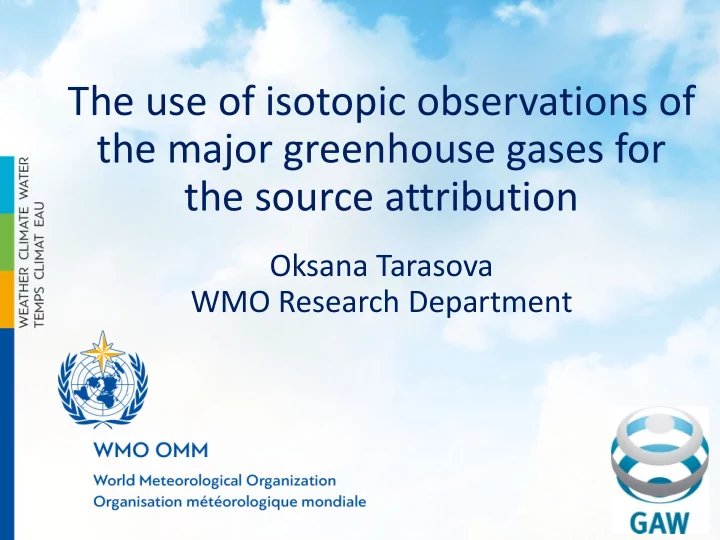

The use of isotopic observations of the major greenhouse gases for the source attribution Oksana Tarasova WMO Research Department
Paris agreement to address climate change Ambition to limit warming to well below 2 °C above pre-industrial levels while • pursuing efforts to limit the temperature increase to 1.5 °C above pre-industrial levels Builds on Nationally Determined Contributions (NDCs) from Parties to the UNFCCC, a • crucial step towards common objective Countries invited to update emission targets by 2020 and every five years • Transparency and reporting on national progress • Players: state stakeholders (national governments), non-state stakeholders (private sector, city governments) The stakeholders need information what emissions to cut, where, how much , and if they did so was there any desirable effect achieved 2016 was the warmest on record – a remarkable 1.1 °C above the pre-industrial period
Emissions and concentrations Paris Agreement aims to achieve 2C by temperature controlling emissions National emissions are calculated radiation following IPCC Guidelines Amount of gases category number Total per (concentrations!!!) category transport NN XX Gt Energy NN XX Gt Agriculture NN XX Gt 16.4 GtCO2 …. … … Total YY Gt +34.1 GtCO2 -11.6 GtCO2 Commitments (e.g. NDC): e.g x % of YY Gt -9.7 GtCO2 +3.5 GtCO2 IN OUT
Can science provide a solution? Yes! Let’s add the atmosphere into the equation : Observations of Transport modelling Emission inventory greenhouse gases Best practices and key principles are documented in the Science Implementation ADDITIONAL Plan for the Integrated Global information on Attribution??? Greenhouse Gas Information emissions System (IG3IS) established by the World Meteorological Organization
Units 1 H 12 C 14 N 16 O 99.985% 98.9% 99.63% 99.75% 2 H 13 C 15 N 17 O 0.015% 1.1% 0.37% 0.038% 3 H 14 C 18 O < 10 - 15 % < 10 - 10 % 0.21% d -notation Isotope ratio 18 O 18 # R SA & 18 = R δ 18 O = − 1 % ( 18 16 O R STD $ ' *1000 ‰ 15 15 N # R SA & 15 = δ 15 N = − 1 R % ( 15 R STD 14 $ ' N
Goals of isotope measurements Global cycles of H, C, N, O – containing Information on sources compounds in the atmosphere CO 2 : 13 C, 14 C, 18 O, 17 O CH 4 : 13 C, 2 H N 2 O : 15 N, 18 O δ value … and sinks x x x x x x OH Cl UV x x x x … and transport δ 13 C s Deposition Loss to stratosphere 1/mole fraction Two components mixture approach
How to distinguish the sources? N 2 O CH 4 (Fischer et al., 2008) ( Emission-weighted average δ 15 N-N 2 O and δ 18 O-N 2 O from continental and marine environments from Snider et al.,2015) The sources are mixed with each other and with a background => several samples with the different contribution of the same source can be used
Global methane changes attribution (From Nisbet et al., 2016)
Fossil fuel CO 2 emissions attribution 14 CO 2 : 12 CO 2 ( D 14 C) is a robust tracer for fossil fuel fluxes: D 14 C ff = -1000 per mil (i.e. zero 14 C) Scaling: -2.7 per mil D 14 C = 1 ppm CO 2 -fossil D 14 C CO 2-ff Atmospheric D 14 C looks just like fossil CO 2 Includes only fossil fuel Miller et al., 2012
Land Use Land Cover Change emissions attribution 3 stations measuring CO 2 and 14 C in • CO 2 are used. Larger uptake than prior model or • bottom up accounting, particularly in forested regions. Differences to bottom up accounting • partly due to differences between LULUCF and what the atmosphere ‘sees’. These issues are still being resolved. Slide: courtesy of Brailsford Gordon, NIWA
Collaboration between IAEA and WMO • IAEA provides reference isotopic materials for observations of the isotopic composition of the greenhouse gases to the global community. Since 1997 IAEA co-organizes jointly with WMO the biennial meetings on Carbon Dioxide, Other Greenhouse Gases, and Related Measurement Techniques. • As about 25% of CO 2 emitted in the atmosphere is absorbed by the ocean, WMO collaborates with IAEA on improved understanding of the ocean acidification processes. • Other areas of collaboration include nuclear preparedness and isotope hydrology research and observations.
Thank you! Merci!
Recommend
More recommend